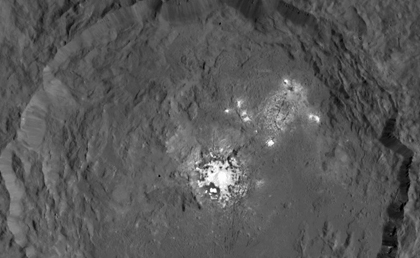Engineers propose using SpaceX rocket and capsule to bring samples back from Mars
Engineering by powerpoint! Several NASA engineers have proposed using SpaceX’s Falcon Heavy rocket and an upgrade of its Dragon capsule to bring samples back from Mars.
The researchers have drawn up a plan that uses a modified version of SpaceX’s uncrewed Dragon cargo capsule, which has already flown six resupply missions to the International Space Station for NASA. The Red Dragon variant would include a robotic arm, extra fuel tanks and a central tube that houses a rocket-powered Mars Ascent Vehicle (MAV) and an Earth Return Vehicle (ERV).
Red Dragon would launch toward Mars atop SpaceX’s huge Falcon Heavy rocket, which is scheduled to fly for the first time next year. After a long deep-space journey, the capsule would touch down near the 2020 Mars rover (whose landing site has not yet been chosen). “Red Dragon can go anywhere the rover can go, as far as landing elevation and terrain,” Gonzales said. “We’re confident we could land in front of the rover and have it drive to us.”
Red Dragon’s robotic arm would then grab a sample from the rover’s onboard cache (assuming the 2020 rover does indeed carry its samples, rather than stash them someplace) and transfer it to a secure containment vessel aboard the ERV, which sits atop the MAV. If something goes wrong during this exchange, Red Dragon can simply scoop up some material from the ground using its arm. The MAV would then blast off from the center of the capsule, like a missile from a silo, sending the ERV on its way back to Earth. The ERV would settle into orbit around our planet; its sample capsule would then be transferred to, and brought down to Earth by, a separate spacecraft — perhaps another Dragon capsule.
I like this concept because it uses available or soon-to-be available resources that are also relatively cheap to adapt for the mission. I also warn everyone that this is, as I note above, engineering by powerpoint. It is a concept, hardly a real proposal. The track record of seeing these kinds of proposals by NASA actually happen is quite poor.
Engineering by powerpoint! Several NASA engineers have proposed using SpaceX’s Falcon Heavy rocket and an upgrade of its Dragon capsule to bring samples back from Mars.
The researchers have drawn up a plan that uses a modified version of SpaceX’s uncrewed Dragon cargo capsule, which has already flown six resupply missions to the International Space Station for NASA. The Red Dragon variant would include a robotic arm, extra fuel tanks and a central tube that houses a rocket-powered Mars Ascent Vehicle (MAV) and an Earth Return Vehicle (ERV).
Red Dragon would launch toward Mars atop SpaceX’s huge Falcon Heavy rocket, which is scheduled to fly for the first time next year. After a long deep-space journey, the capsule would touch down near the 2020 Mars rover (whose landing site has not yet been chosen). “Red Dragon can go anywhere the rover can go, as far as landing elevation and terrain,” Gonzales said. “We’re confident we could land in front of the rover and have it drive to us.”
Red Dragon’s robotic arm would then grab a sample from the rover’s onboard cache (assuming the 2020 rover does indeed carry its samples, rather than stash them someplace) and transfer it to a secure containment vessel aboard the ERV, which sits atop the MAV. If something goes wrong during this exchange, Red Dragon can simply scoop up some material from the ground using its arm. The MAV would then blast off from the center of the capsule, like a missile from a silo, sending the ERV on its way back to Earth. The ERV would settle into orbit around our planet; its sample capsule would then be transferred to, and brought down to Earth by, a separate spacecraft — perhaps another Dragon capsule.
I like this concept because it uses available or soon-to-be available resources that are also relatively cheap to adapt for the mission. I also warn everyone that this is, as I note above, engineering by powerpoint. It is a concept, hardly a real proposal. The track record of seeing these kinds of proposals by NASA actually happen is quite poor.

